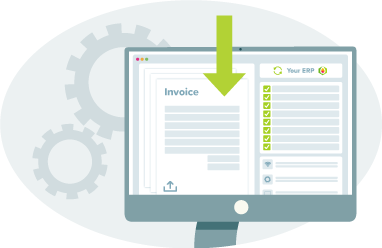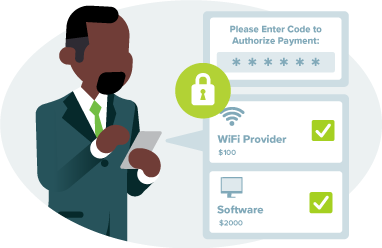What is Invoice-to-Pay?

What is Invoice-to-Pay?
Invoice-to-Pay is the accounts payable (AP) process of managing, processing, and paying supplier invoices. When a supplier sends goods or provides services to a customer, they will then send a statement of the money owed with a payment request to the buyer. This is the first step in making supplier payments.
What is the Invoice-to-Pay Process?
Traditionally, the invoice-to-pay process is all manual: A supplier generates an invoice, the AP team receives it, enters invoice data into their accounting system, collects signatures, approves payment, prints paper checks, and finally mails the invoice payment to the supplier. The traditional invoice processing system is expensive, time-consuming, prone to fraud, and ultimately strains supplier relationships. Many AP teams don’t realize that they can manage this process more efficiently. But they can!
How Does an Automated Invoice-to-Pay Platform Work?
An invoice-to-pay platform simplifies the end-to-end AP process with automation that increases the efficiency of AP teams while mitigating fraud risk and providing greater visibility and control over AP spend. Let’s take a look.

Automated Data Capture & Coding
Automated invoice data capture speeds up invoice processing by extracting header and line-level information from invoices and automatically syncing them with your company’s ERP. Invoices are coded at 99.5% accuracy so the risk of recording incorrect supplier information is eliminated.

Automatic Routing for On-the-Go Approvals
With an invoice-to-pay platform, you can set approval rules to automatically route invoices to the appropriate stakeholders for approval, with automated reminders so you never have to chase anyone down. You can easily configure routing logic to your existing policies and tiers. Best of all, invoice approvers can then make approvals from anywhere, at any time.

Simplified Payment Authorization
Financial leaders can easily authorize and schedule payments with a single click of a button with simplified payment authorization. You can also take advantage of payment controls such as two-factor authentication, dual approvals, and segregation of duties. These capabilities further protect your organization against payment fraud.

Speedy Payment Execution and Remittance
Once a payment has been authorized, the invoice will be automatically paid on your behalf, streamlining the entire invoice-to-pay process. MineralTree pays each supplier using the optimal payment method: virtual card, ACH, international payment, or check. We continuously optimize your payment mix by enrolling new and existing suppliers, while managing day-to-day inquiries. Detailed remittance on every payment will be sent to your vendor electronically, providing transparency within each payment made.
What are the Benefits of an Automated Invoice-to-Pay Process?
Automated invoice-to-pay allows businesses to streamline their end-to-end AP workflow with easy, dependable, and efficient payment processing. Here are some of the benefits you can expect to gain from an automated invoice-to-pay platform:
Why Automate Invoice Processing with MineralTree?
MineralTree TotalAP is the ultimate invoice-to-pay solution. TotalAP eliminates inefficiencies at every pain point in the accounts payable process and enables more than 2,000 businesses to improve operations, mitigate fraud and risk, simplify reconciliation, bolster supplier relationships, generate cash back savings, and enhance internal accounting controls.
MineralTree does this by streamlining the entire AP process with invoice capture and coding, automatic approval routing, and flexible payments that allow your business to utilize any payment method — including virtual cards to further protect your business against fraud and generate cash-back rebates. Want to learn more? Let’s get in touch!
Invoice-to-Pay FAQs
Why is a Streamlined Invoice-to-Pay Process Important?
A streamlined invoice-to-pay process increases the efficiency of AP teams and helps strengthen vendor relationships while mitigating fraud risk. It also provides greater visibility and control over AP spend.
What Business Terms are Most Common When Discussing Invoice-to-Pay?
There are several terms within the invoice-to-pay process. Here are the most common terms you should know:
- Cash in Advance (CIA): Requires buyer to pay for goods or services before any work is done or goods are received.
- Payment in Advance (PIA): Requires the buyer to pay the total invoice amount upfront.
- 50% Upfront: Requires the buyer to pay 50% of the total invoice amount upfront.
- 15 Month Following Invoice (MFI): Requires buyer to pay the invoice on the 15th of the month after receiving the invoice.
- End of Month (EOM): Requires buyer to pay by the end of the month after receiving the invoice.
- Net 7 (21, 30): Requires buyer to pay 7 (21, 30) days after an invoice is received.
What are the Steps in an Invoice-to-Pay Process?
The traditional invoice-to-pay process is as follows:
1. A supplier generates an invoice.
2. The AP team receives it.
3. The AP team enters the invoice data into their accounting system.
4. The AP team sends the invoice for approval. 5. Designated individuals authorize the payment.
6. The AP team prints and cuts a paper check.
7. The AP team sends invoice payment to the supplier.
8. The AP team manually updates their ERP system once payment is made.
This traditional invoice processing approach is expensive, time-consuming, prone to fraud, and ultimately strains supplier relationships. As a result, many AP teams have switched their manual processes to an automated AP software to optimize and streamline their invoice-to-pay workflow.
How are Invoices Read and Recorded?
Invoices can be read and processed in a few different ways. The most common ways include:
- Physical mail
- Fax
- Invoice Capture
- Supplier Portal




